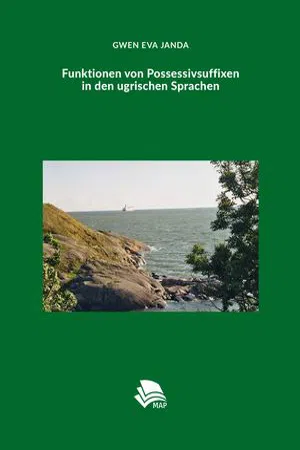
- English
- PDF
- Available on iOS & Android
Funktionen von Possessivsuffixen in den ugrischen Sprachen
About this book
The Ugric languages Mansi, Khanty and Hungarian form a branch of the Uralic language family which is mainly spread across North-Eastern Europe and Siberia. Other prominent languages of the Uralic family are e.g. Finnish, Saami and Estonian. The Ob-Ugric languages Mansi and Khanty are spoken in Western Siberia along the Ob' river and its tributaries, thus they are referred to as Ob-Ugric. Their closest relative is Hungarian, spoken in Hungary and its neighboring countries. The status of the Khanty and Mansi languages is endangered: only 20% out of 8, 000 ethnic Mansi and 30% out of 22, 000 ethnic Khanty still speak their mother tongue, and there are nearly no monolingual speakers. In contrast, Hungarian is an official language of the European Union, spoken by about 15 million people. Hence, the status of literacy, language documentation and language education differs noticeably between Ob-Ugric and Hungarian. From a typological point of view, the Ugric languages are basically so-called SOV languages, their morphology is mainly agglutinative, i.e. grammatical information is rather encoded with suffixes which are attached to the stem instead of using prepositions, pronouns or articles. The most accessible referent in a discourse is not overtly realized on the surface of the sentence. Its position remains empty (zero-anaphora). This is also revealed in rich paradigms of personal suffixes which are used instead. One set of personal suffixes is attached to nominal stems and called possessive suffixes. They are involved in the structure of so-called attributive possessive constructions in most Uralic languages. As revealed in their denomination, research on possessive suffixes in Ugric languages, as in most Uralic languages, has primarily viewed them in the light of their function as markers of possessive relations, traditionally referred to as their prototypical use. The linguistic concept of possession seems to be universal. The notion of possession itself, though, is purely abstract and can only be understood as a »broader concept of association or relationship between two nouns«. While the definition is an abstract collective term, there is a broad consensus among linguists that certain prototypical meanings are covered by the concept of possession. These are: part-whole relations, kinship relations (both by blood and marriage), ownership relations as well as a fourth column covering all kinds of association in general (e.g. attribution, properties or orientation/location). The use of attributive possessive constructions is very frequent in most Uralic languages and, in a considerable amount of cases, a possessive reading of the relation is excluded, even in the most abstract interpretation of possession. Such cases, where the so-called prototypical use of possessive suffixes (i.e. denoting a possessive relation) fails to serve as an explanation, are frequently subsumed under the node of non-prototypical use and a secondary, non-possessive function is attributed to possessive suffixes. This secondary function is for instance likened to the properties of a definite article.
Frequently asked questions
- Essential is ideal for learners and professionals who enjoy exploring a wide range of subjects. Access the Essential Library with 800,000+ trusted titles and best-sellers across business, personal growth, and the humanities. Includes unlimited reading time and Standard Read Aloud voice.
- Complete: Perfect for advanced learners and researchers needing full, unrestricted access. Unlock 1.4M+ books across hundreds of subjects, including academic and specialized titles. The Complete Plan also includes advanced features like Premium Read Aloud and Research Assistant.
Please note we cannot support devices running on iOS 13 and Android 7 or earlier. Learn more about using the app.
Information
Table of contents
- Half title Page
- Series Page
- Title Page
- Copyright
- Inhalt
- Danksagung
- English Summary
- Einleitung
- 1. Forschungsgegenstand
- 2. Forschungsstand
- 3. Theoretische Grundlagen
- 4. Daten und Methodik
- 5. Ergebnis und Diskussion
- Schluss
- Verzeichnis der Abkürzungen und Glossierungen
- Abbildungsverzeichnis
- Tabellenverzeichnis
- Quellen